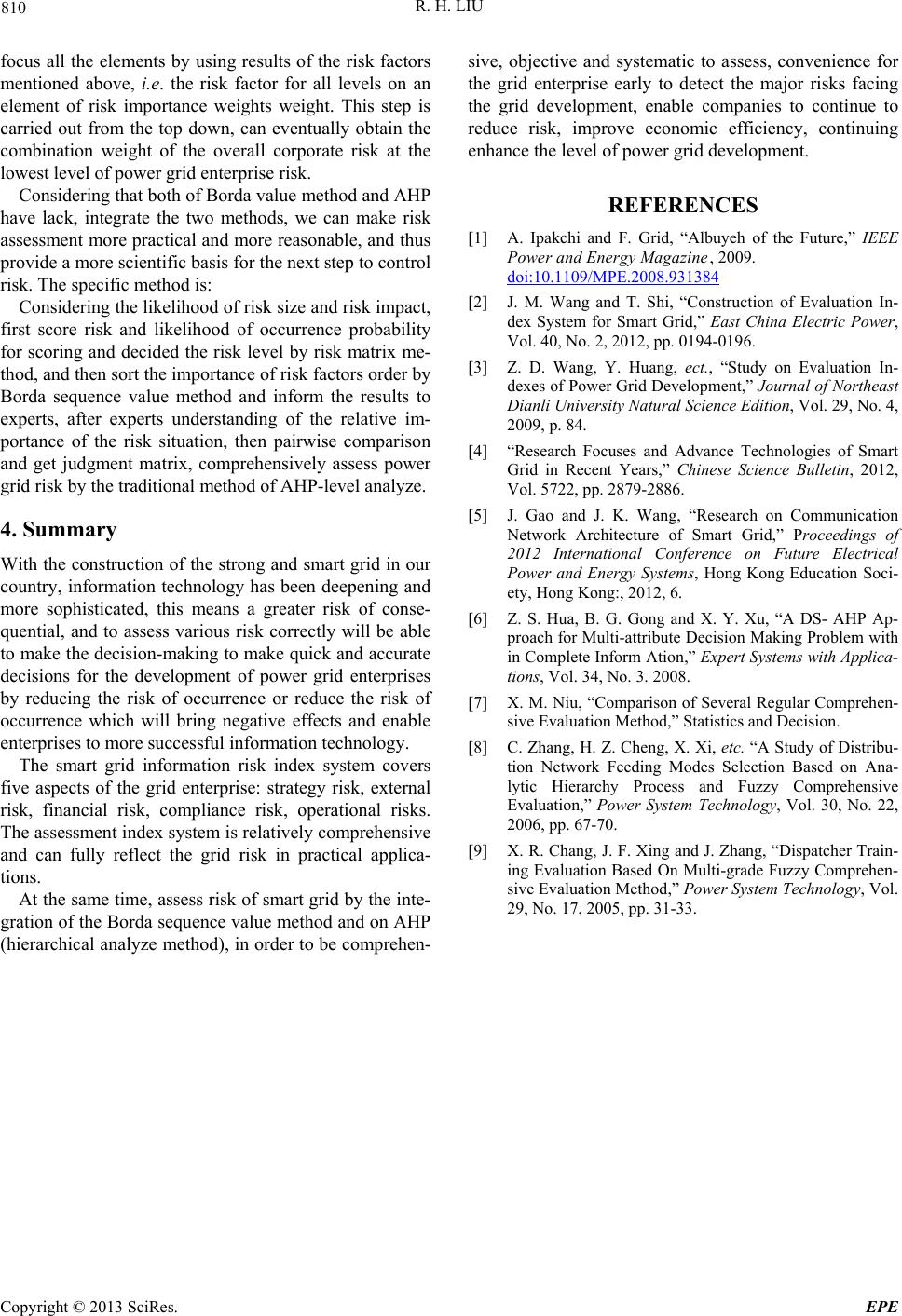
R. H. LIU
Copyright © 2013 SciRes. EPE
810
focus all the elements by using results of the risk factors
mentioned above, i.e. the risk factor for all levels on an
element of risk importance weights weight. This step is
carried out from the top down, can eventually obtain the
combination weight of the overall corporate risk at the
lowest level of power grid enterprise risk.
Considering that both of Borda value method and AHP
have lack, integrate the two methods, we can make risk
assessment more practical and more reasonable, and thus
provide a more scientific basis for the next step to control
risk. The specific method is:
Considering the likelihood of risk size and risk impact,
first score risk and likelihood of occurrence probability
for scoring and decided the risk level by risk matrix me-
thod, and then sort the importance of risk factors order by
Borda sequence value method and inform the results to
experts, after experts understanding of the relative im-
portance of the risk situation, then pairwise comparison
and get judgment matrix, comprehensively assess power
grid risk by the traditional method of AHP-level analyze.
4. Summary
With the construction of the strong and smart grid in our
country, information technology has been deepening and
more sophisticated, this means a greater risk of conse-
quential, and to assess various risk correctly will be able
to make the decision-making to make quick and accurate
decisions for the development of power grid enterprises
by reducing the risk of occurrence or reduce the risk of
occurrence which will bring negative effects and enable
enterprises to more successful information technology.
The smart grid information risk index system covers
five aspects of the grid enterprise: strategy risk, external
risk, financial risk, compliance risk, operational risks.
The assessment index system is relatively comprehensive
and can fully reflect the grid risk in practical applica-
tions.
At the same time, assess risk of smart grid by the inte-
gration of the Borda sequence value method and on AHP
(hierarchical analyze method), in order to be comprehen-
sive, objective and systematic to assess, convenience for
the grid enterprise early to detect the major risks facing
the grid development, enable companies to continue to
reduce risk, improve economic efficiency, continuing
enhance the level of power grid development.
REFERENCES
[1] A. Ipakchi and F. Grid, “Albuyeh of the Future,” IEEE
Power and Energy Magazine, 2009.
doi:10.1109/MPE.2008.931384
[2] J. M. Wang and T. Shi, “Construction of Evaluation In-
dex System for Smart Grid,” East China Electric Power,
Vol. 40, No. 2, 2012, pp. 0194-0196.
[3] Z. D. Wang, Y. Huang, ect., “Study on Evaluation In-
dexes of Power Grid Development,” Journal of Northeast
Dianli University Natural Science Edition, Vol. 29, No. 4,
2009, p. 84.
[4] “Research Focuses and Advance Technologies of Smart
Grid in Recent Years,” Chinese Science Bulletin, 2012,
Vol. 5722, pp. 2879-2886.
[5] J. Gao and J. K. Wang, “Research on Communication
Network Architecture of Smart Grid,” Proceedings of
2012 International Conference on Future Electrical
Power and Energy Systems, Hong Kong Education Soci-
ety, Hong Kong:, 2012, 6.
[6] Z. S. Hua, B. G. Gong and X. Y. Xu, “A DS- AHP Ap-
proach for Multi-attribute Decision Making Problem with
in Complete Inform Ation,” Expert Systems with Applica-
tions, Vol. 34, No. 3. 2008.
[7] X. M. Niu, “Comparison of Several Regular Comprehen-
sive Evaluation Method,” Statistics and Decision.
[8] C. Zhang, H. Z. Cheng, X. Xi, etc. “A Study of Distribu-
tion Network Feeding Modes Selection Based on Ana-
lytic Hierarchy Process and Fuzzy Comprehensive
Evaluation,” Power System Technology, Vol. 30, No. 22,
2006, pp. 67-70.
[9] X. R. Chang, J. F. Xing and J. Zhang, “Dispatcher Train-
ing Evaluation Based On Multi-grade Fuzzy Comprehen-
sive Evaluation Method,” Power System Technology, Vol.
29, No. 17, 2005, pp. 31-33.